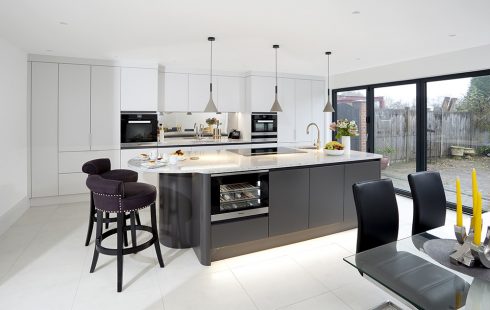With over 40 years’ experience of building bespoke kitchens we have come across a lot of innovation. This can affect their design in a variety of ways and it’s useful every now and then to consider, in no particular order, what innovations, or trends, are apparent today.
Integrated appliances

Sous vide & vacuum
Fitted appliances are nothing new but the level of integration is increasing as each new appliance finds a place in kitchen design. This is apparent with drawer dishwashers – where you can scale your dishwashing capacity up or down by using one, two or three drawers. Another area is extractors which as
this blog shows have moved on from a simple canopy over the oven to a downdraught extractor that rises up from the work surface to draw odours and steam horizontally from the hob.
Increasing popularity of sous vide cooking, encouraged by the ever-expanding cookery media has increased interest in vacuum packers and water baths as well as flash freezers. These, can be contained within one vertical unit or spread around your kitchen. From an ergonomic point of view it’s best to plan the layout of your kitchen carefully, perhaps around the traditional
kitchen triangle principles.
Storage

Modern pantry
Storage in the kitchen has always been and will remain a hot topic as designers try and make it easier for us to have an uncluttered workspace. Let’s face it we spend so much on the clean lines of our bespoke kitchen the last thing we want to do is to clutter it up with lots of cooking utensils, appliances, crockery and other paraphernalia. It’s as if we don’t want our kitchens to be immediately recognisable as a kitchen. Drawers have become one of the answers with stronger, well-made units taking saucepans and small electric appliances.

Colourful display
Clever storage – larder, pull-outs, swing larders and carousels – have revolutionised cabinetmaking allowing us to use every square inch of hard-to-reach space. Cabinets have become smooth, sleek storage receptacles with tall units dividing rooms with storage. Similarly companies like Hafele have introduced spacious yet compact bins to allow recycling and yet still take up the minimum amount of space.
Having said that, some of us are going a bit retro and reverting to open shelving or glass-fronted cabinets – with a bespoke kitchen you can have what you like. This might reflect a wish to display attractive crockery, linen or ornaments. With good cabinet making and sliding doors you can create display areas that can be hidden when not wanted. LED lighting can emphasise or down-play areas.
Entertainment, lighting and environment
As we have said many times – the kitchen is no longer a pokey corner where Mum prepares food to be eaten in the dining room. Nowadays the kitchen is the centre of the home and often a place for entertainment. Because of this seating areas are increasing with occasional breakfast bars at islands as well as proper dining table eating areas. Plumbed music is obligatory as is a large screen TV and strong WiFi. Kitchens have temperature-controlled wine fridges as well as automated lighting, including many more LED lighting options.

LEDs add changeable colour
LED lighting offers an environmental and flexible improvement – giving the ability to dim and change colours to adjust to the mood. Many kitchens are opening out onto the garden with large windows and bi-fold doors. Vaulted ceilings allow for roof windows. All this natural light is a good way to keep energy bills down during the day. Other environmental improvements to the kitchen are the use of reclaimed wood and better insulated windows and doors. Everything is relative however and kitchens will probably always remain the least environmentally friendly of rooms due to their high energy demands for heat and refrigeration.
Islands – no longer innovation

Islands are here to stay
While not a new innovation, islands are cementing their place in the kitchen by providing seating and eating areas, extra storage and work surfaces. They are normally central areas that encourage social interaction like a big bar in the middle of the space. The chef also gets the chance of joining in; facing guests and being involved while still able to prepare food.
We rarely design, build and install a large kitchen now without an island and so we see islands as having moved away from innovation and into the ‘basic requirement’ category.
Décor

A statement wall
White, off white, cream and increasingly, grey, kitchens still predominate but we have noticed a growth in ‘accent’ ‘statement’ or ‘wow’ colours. Some customers use a blaze of colour – often contrasting with a neutral, traditional background colour – to set their kitchen apart from the norm and create energy and excitement.
Colours like blue, red, green and yellow can be used as a foil for matching lampshades, window fabrics or appliances.
Hot taps

Quooker Flex
One of the hottest of trends – hot taps are moving onto everyone’s wish list as suppliers like Insinkerator, Quooker and Grohe produce better and better products. Quooker has just introduced the Flex; a hot tap with an adjustable hose for using over a sink – a development that reflects how this ‘gadget’ has become mainstream.
Worktops

Cimstone worktop and glass splashback
We have covered this recently in another
blog. This blog reflects, among other things, another trend we have noticed – the growth in quartz and composite stone at the expense of granite. This is probably down to its wider availability and the wide range of colours/textures that suppliers like Cimstone, Caesarstone and Arenastone provide. Corian, while expensive, is also holding its own with its ability to be sculpted like wood and excellent water resistance.
Smart kitchens

Amazon Genican reorders trash
This is an emerging trend as appliance manufacturers embrace the ‘Internet of Things’. We already embrace Amazon Echo, Google Home and Dyson robot cleaners as well as Lutron automated lighting. Looking to the US we can see Amazon’s Dash Wand and Dash Hub that scan your larder and order where necessary or its Genican – a waste bin that scans packaging as you discard it and offers you the option to re-order. There are also smart cookers, Samsung’s Family Hub Refrigerator, smart decanters, coffee machines and a host of concepts that help us reorder, reduce waste, instruct our kitchen remotely and eat more healthily. Smart home apps are already here with products like Nest and others will follow – no wonder the market is set to grow by nearly 30% a year.
These are just a few thoughts on where we are in 2017. What is certain is that the kitchen will remain the centre of the home and the centre of attention when it comes to domestic innovation.
For more info on the InSinkerator visit the website here >>


